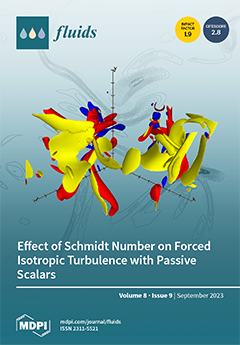This critical review delves into the impact of Computational Fluid Dynamics (CFD) modeling techniques, specifically 2D, 2.5D, and 3D simulations, on the performance and vortex dynamics of Darrieus turbines. The central aim is to dissect the disparities apparent in numerical outcomes derived from
[...] Read more.
This critical review delves into the impact of Computational Fluid Dynamics (CFD) modeling techniques, specifically 2D, 2.5D, and 3D simulations, on the performance and vortex dynamics of Darrieus turbines. The central aim is to dissect the disparities apparent in numerical outcomes derived from these simulation methodologies when assessing the power coefficient (
) within a defined velocity ratio (
) range. The examination delves into the prevalent turbulence models shaping
values, and offers insightful visual aids to expound upon their influence. Furthermore, the review underscores the predominant rationale behind the adoption of 2D CFD modeling, attributed to its computationally efficient nature vis-à-vis the more intricate 2.5D or 3D approaches, particularly when gauging the turbine’s performance within the designated
realm. Moreover, the study meticulously curates a compendium of findings from an expansive collection of over 250 published articles. These findings encapsulate the evolution of pivotal parameters, including
, moment coefficient (
), lift coefficient (
), and drag coefficient (
), as well as the intricate portrayal of velocity contours, pressure distributions, vorticity patterns, turbulent kinetic energy dynamics, streamlines, and Q-criterion analyses of vorticity. An additional focal point of the review revolves around the discernment of executing 2D parametric investigations to optimize Darrieus turbine efficacy. This practice persists despite the emergence of turbulent flow structures induced by geometric modifications. Notably, the limitations inherent to the 2D methodology are vividly exemplified through compelling CFD contour representations interspersed throughout the review. Vitally, the review underscores that gauging the accuracy and validation of CFD models based solely on the comparison of
values against experimental data falls short. Instead, the validation of CFD models rests on time-averaged
values, thereby underscoring the need to account for the intricate vortex patterns in the turbine’s wake—a facet that diverges significantly between 2D and 3D simulations. In a bid to showcase the extant disparities in CFD modeling of Darrieus turbine behavior and facilitate the selection of the most judicious CFD modeling approach, the review diligently presents and appraises outcomes from diverse research endeavors published across esteemed scientific journals.
Full article





